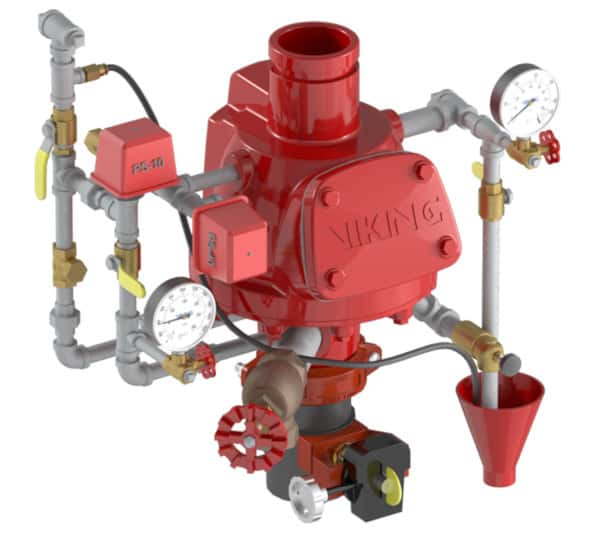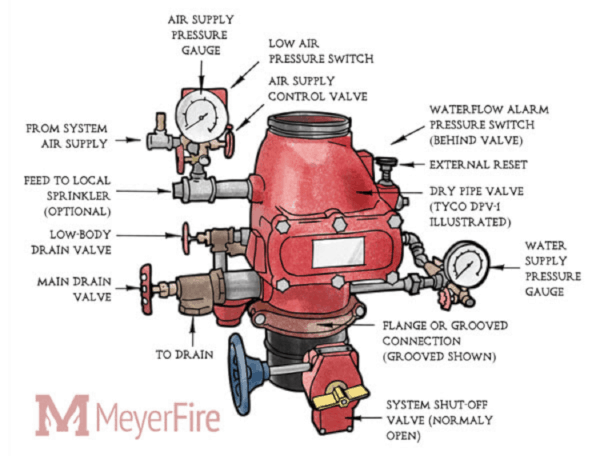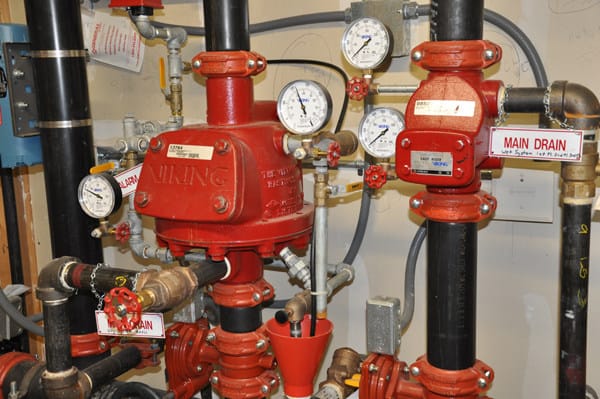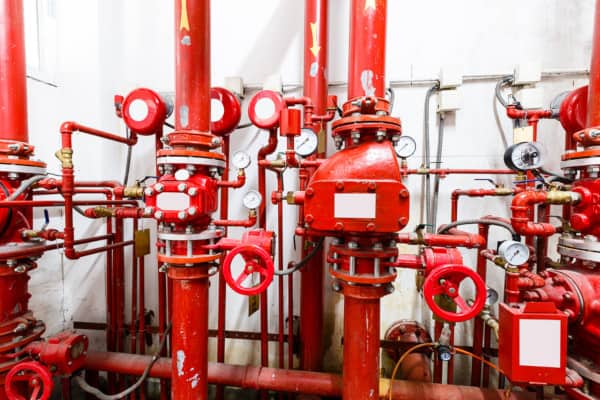Annual dry pipe sprinkler system trip tests ensure dry pipe valves function properly
It’s arguable that nothing is more essential to the reliable operation of a dry sprinkler system than the dry pipe valve. If it remains stubbornly closed when sprinkler heads are activated, the water supply will never reach the fire, rendering the sprinkler system useless. And if it trips improperly, a property could face water damage. This is why dry pipe sprinkler system trip tests are crucial.
In this installment of our series on dry sprinkler systems, we examine the National Fire Protection Association (NFPA) requirements and best practices for dry pipe sprinkler system trip tests, as well as for performing an associated test on main drains.
Are you looking to buy components for your building’s sprinkler system? QRFS offers a range of dry sprinkler heads available on special order. Simply give us a call at 888.361.6662 or email support@qrfs.com.
You can also view our in-stock selection of sprinkler gauges, valves, supervisory switches, and other accessories.
Mark your calendars: Kick off spring with dry pipe sprinkler system trip tests
Dry sprinkler systems offer property owners peace of mind by providing reliable fire protection when temperatures drop below freezing. They avoid the leaky or burst pipes that plague wet sprinkler systems in cold temperatures by relying on pressurized air or nitrogen to hold a dry pipe valve closed until one or more sprinkler heads are activated by a fire.
Dry pipe valves act like sentries in dry sprinklers, guarding the system’s water supply in a heated space until it’s needed to douse a fire. The 2017 edition of NFPA 25: Standard for the Inspection, Testing, and Maintenance of Water-Based Fire Protection Systems requires partial-flow trip tests to be conducted annually—and full-flow trip tests to be performed at least every three years—to ensure that these valves will open when needed and send water flowing to the sprinkler heads. Partial-flow tests don’t need to be performed in the years that full-flow tests are conducted.
While the standard makes it clear that property owners or their representatives are ultimately responsible for ensuring their sprinkler systems are functioning properly, it does grant the ability to delegate authority to accomplish this (4.1.1). Trip tests rank among the most complicated dry sprinkler system tests and can require multiple qualified ITM professionals to physically operate the system to make sure it performs to an acceptable standard.
From the 2017 edition of NFPA 25
13.4.5.2.2* Each dry pipe valve shall be trip tested annually during warm weather.
13.4.5.2.2.1 Dry pipe valves protecting freezers shall be trip tested in a manner that does not introduce moisture into the piping in the freezers.
13.4.5.2.2.2* Every 3 years and whenever the system is altered, the dry pipe valve shall be trip tested with the control valve fully open and the quick-opening device, if provided, in service.
13.4.5.2.2.3* During those years when full flow testing in accordance with 13.4.5.2.2.2 is not required, each dry pipe valve shall be trip tested with the control valve partially open.
13.4.5.2.2.4 When refilling a dry system, the air supply shall be capable of restoring normal air pressure in the system within 30 minutes.
13.4.5.2.2.5 The requirements of 13.4.5.2.2.4 shall not apply in refrigerated spaces maintained below 5°F (–15°C), where normal system air pressure shall be permitted to be restored within 60 minutes.
13.4.5.2.3 Grease or other sealing materials shall not be applied to the seating surfaces of dry pipe valves.
NFPA guidelines officially call for trip tests to be performed in “warm weather,” but to avoid ice plugs from forming when temperatures drop, it clarifies that spring is really the best season for testing (A.13.4.5.2.2). That allows plenty of time before cold weather begins for all the water that was pushed through the system to drain to low points or back to the dry pipe valve.
Grease and other sealing materials are forbidden because they may damage the rubber components of the dry pipe valve and inhibit its operation.

What’s the difference between partial-flow and full-flow tests?
During the extensive full-flow test, the control valve is fully opened so water floods the sprinkler system. But during the annual partial-flow test, the control valve is only partially opened, preventing water from surging throughout the system. This greatly reduces the time needed to drain and reset the system after the test.
Even so, a partial-flow test should allow the dry valve’s clapper to pop up and latch. In the closed position, the clapper acts like a dam on a river, dividing the dry system’s wet and dry pipes. If the clapper doesn’t latch, the test is a failure and should be performed again once repairs are made. However, there is an exception: for certain dry pipe valve models, a partial flow test may not provide a high enough rate of flow to latch the clapper in the open position. If the manufacturer’s instructions indicate that this is the case for your model, it’s important to test that the latching equipment is operative when resetting the valve.
The full-flow test requires two technicians: one at the dry pipe valve and the other at the inspector’s test connection, which is usually located at the end of the highest, most distant sprinkler pipe on a dry system. During full-flow tests, dry sprinkler systems don’t have to deliver water to the inspector’s test connection within the 60-second timeframe generally required by NFPA during a fire. Instead, the water delivery time is compared to results from the original acceptance test, which was performed right after the system was installed. If the current delivery time is longer, it could indicate issues with the system or the water supply that need to be investigated.
Partial-flow tests can usually be conducted by a single technician as long as the control valve isn’t a wall post indicating or post indicating valve type. Post indicator systems enable testers to exercise hard-to-access valves through a post that manipulates the valve and indicates whether it’s open or closed.

Dry pipe sprinkler system trip tests include several dry sprinkler components
Read this carefully before starting: Once a dry pipe valve is tripped, there’s no going back to document previous static pressures. So, before jumping into the trip test, a professional must take time to assess the equipment and factors that might impact the performance and accuracy of the test results. Notice if there is a quick-opening device and make sure the air compressor or nitrogen generator is operational. It’s also important to note the system’s water pressure and whether it’s supplemented by a fire pump.
Document relevant pressures before starting the test, such as air, water, and quick-opening device. Trip tests are performed to ensure that the valve will operate reliably if needed, so it’s important to ensure that the starting parameters are accurate, so the final results are accurate as well.
Testing of several other dry sprinkler components is performed during the annual partial-flow test according to their manufacturer’s instructions, including air maintenance devices, quick-opening devices, and low air pressure alarms. Low-temperature alarms on the heated valve enclosures that keep dry pipe valves from freezing in cold temperatures should also be tested annually at the beginning of every heating season.
Careful records of previous dry pipe sprinkler system trip tests must be kept on the premises so they can be easily compared to current results. If the data is markedly different, an investigation should be conducted to uncover and fix the source of the problem.
From the 2017 edition of NFPA 25
13.4.5.2.4* Quick-opening devices, if provided, shall be tested quarterly.
13.4.5.2.5 A tag or card that shows the date on which the dry pipe valve was last tripped, and the name of the person and organization conducting the test, shall be attached to the valve.
13.4.5.2.5.1 Separate records of initial air and water pressure, tripping air pressure, and dry pipe valve operating conditions shall be maintained on the premises for comparison with previous test results.
13.4.5.2.5.2 Records of dry pipe valve tripping time and water transit delivery time to the inspector’s test connection shall be maintained for full flow trip tests.
13.4.5.2.6* Low air pressure alarms, if provided, shall be tested annually in accordance with the manufacturer’s instructions.
13.4.5.2.7 Low temperature alarms, if installed in valve enclosures, shall be tested annually at the beginning of the heating season.
13.4.5.2.8 Automatic air pressure maintenance devices, if provided, shall be tested annually during the dry pipe valve trip test in accordance with the manufacturer’s instructions.
Guidelines on how to perform a full-flow trip test (NFPA 25: A.13.4.5.2.2.2)
- The area protected by the dry system will not have protection or alarms in service while the dry valve is tested, so it’s essential to follow your facility’s impairment program before you start. Notify your alarm company, fire department, and insurance carrier that you are working on the system and will advise them when it’s back in service. A fire watch should also be implemented, and managers informed that the system and alarms are impaired.
- Gather everything needed. Make sure to have the right tools to reset the valve after the test. A tester should also have at least one stopwatch or watch with a second hand. Install calibrated test gauges on the water and air sides of the system. Two-way radios are handy for sharing key times during the test: the dry pipe valve trip time and the time the water takes to reach the inspector’s test connection.
- Consider performing a main drain test to clean any accumulated scale and debris from the supply water piping. Make sure the main drain valve is closed before starting the trip test.
- Record both the water and air or nitrogen pressures before the test. One technician will remain at the valve to watch the gauges and time the valve trip with a stop watch, while the other goes to the inspector’s test connection.
- The system’s air or nitrogen pressure is relieved by completely opening the inspector’s test valve. At the same time, both testers should start their stopwatches. If two-way communication is impossible, the technician at the dry valve should start his or her stopwatch as soon as downward movement begins on the air pressure gauge.
- The technician at the dry valve will continue to monitor the air gauge, recording the time and air pressure at the valve trip. The trip is usually easy to observe. Not only should the technician hear the valve trip, but the air gauge will jump from the trip pressure and increase as water flows into the piping. Many times, the sprinkler piping will also shake.
- The tester at the inspector’s test connection should note the time at which water flows steadily from the test connection, which shows how long it took to travel from the opened valve. This is not meant to be a pass/fail criterion and is only noted for comparison to previous tests. NFPA 13: Standard for the Installation of Sprinkler Systems doesn’t require water delivery within 60 seconds for all dry sprinkler systems.
- Close the main water supply valve and terminate the test when clean water flows from the inspector’s test connection.
- Record the air or nitrogen pressure and the time elapsed as follows:
- From the complete opening of the test valve to the tripping of the valve
- From the complete opening of the inspector’s valve to the start of the steady flow from the test connection
- Open all low-point drains until water stops flowing.
- Reset the dry pipe valve and any quick-opening device, if installed, according to the manufacturer’s instructions.
- Compare the data of trip pressure, trip time, and water delivery time to the inspector’s test connection with previous test records. If the data differs significantly, the cause should be investigated, and repairs or corrections should be made.
- If repairs or corrections are performed, the test should be repeated until the valve performs properly.
Watch this video to observe full-flow and partial-flow dry pipe sprinkler system trip tests—warning: you might want to hit the mute button to avoid the bizarre music choice:
How to perform a partial-flow trip test (A.13.4.5.2.2.3)
- Fully open the main drain valve to clean any accumulated scale or foreign material from the supply water piping.
- Close the control valve at the incoming water supply until a full stream of water isn’t flowing from the main drain outlet and additional closure wouldn’t provide flow through the drain outlet’s entire area.
- Close the feed line to the quick-opening device, if installed.
- Record the system air or nitrogen pressure and the supply water pressure.
- Reduce the system’s air or nitrogen pressure by slowly opening the priming level test valve or the inspector’s test valve.
- Record the air or nitrogen pressure and supply water pressure when the dry pipe valve trips.
- Immediately close the system control valve and open the main drain valve to minimize the amount of water entering the system piping.
- Trip test the quick-opening device, if installed, according to the manufacturer’s instructions. These steps can usually be followed once step 7 is performed (13.4.5.2.4):
- Open the valve for the quick-opening device feed line.
- Open the inspector’s test valve and record the time it takes to trip. A rush of air from the device indicates that it has tripped.
- Close the inspector’s test valve after the quick-opening device trips.
- Return the device to service in accordance with the manufacturer’s instructions after the partial-flow test is completed.
- Open all low point drains until water ceases to flow.
- Reset the dry pipe valve and quick-opening device, if installed, according to the manufacturer’s instructions and return the system to service.

Main drain testing goes hand-in-hand with dry pipe sprinkler system trip tests
Main drains are installed on dry sprinkler system risers to drain water from the overhead piping after the system is turned off. That way, contractors or maintenance crew members can easily perform work on the system or replace nozzles after a fire or if the system is otherwise deployed.
While main drain tests are required annually on every water supply lead-in or any time the water supply control valve is closed, it’s recommended to also perform them before trip testing to clean any accumulated scale or debris from the water supply. If the system includes a backflow preventer, the main drain test of at least one system downstream of it must be performed quarterly.
The main drain test essentially measures the water pressure in a sprinkler system. It’s designed to detect changes that could impact sprinkler performance, ensure that the proper water supply is available at the system riser, and confirm that drain valves are operational. It also aims to reveal significant reductions in water flow to the system that might indicate a major obstruction, nearly-closed valve, dropped gate, or check valve clapper that’s stuck to the valve seat.
From one test to another, the measurement shouldn’t change by more than 10 percent—if it does, it could indicate a problem. While that isn’t common, if the city is performing work on pipes near your building, for instance, rocks and mud could make their way into your main drain and cause a blockage. Normal wear and tear could also cause a leak.
Since the discharge water is often piped outside, it’s best to avoid performing this test in the winter when the water can turn to ice and lead to injuries. Data collected from the suction gauges during a fire pump flow test that test the water supply should satisfy the requirements of a main drain test.
But read this carefully: the NFPA warns that a favorable main drain test—or one that matches the results of previous tests—doesn’t necessarily mean your dry sprinkler system is in perfect order, with all passages unobstructed and all valves fully opened. It’s important to continue to watch for signs of trouble. It does, however, provide a reasonable level of confidence that the water supply isn’t blocked.
From the 2017 edition of NFPA 25
13.2.5* Main Drain Test. A main drain test shall be conducted annually for each water supply lead-in to a building water-based fire protection system to determine whether there has been a change in the condition of the water supply.
13.2.5.1 Where the lead-in to a building supplies a header or manifold serving multiple systems, a single main drain test shall be permitted.
13.2.5.2 In systems where the sole water supply is through a backflow preventer and/or pressure-reducing valves, the main drain test of at least one system downstream of the device shall be conducted on a quarterly basis.
13.2.5.3 When there is a 10 percent reduction in full flow pressure when compared to the original acceptance test or previously performed tests, the cause of the reduction shall be identified and corrected if necessary.
Follow these steps to conduct a main drain test (A.13.2.5)
- Record the pressure indicated by the supply water gauge before you start. This is known as static pressure.
- Close the alarm control valve on alarm valves.
- Slowly and fully open the main drain valve.
- After the flow has stabilized, record the residual (flowing) pressure indicated by the water supply gauge.
- Close the main drain valve by turning it slowly.
Watch this video for more step-by-step instructions for performing a main drain test:
Complex dry pipe sprinkler system trip test steps require constant focus
A dry pipe sprinkler system trip test may seem straightforward, but it involves many complicated, precisely-timed steps—and losing focus for an instant during the testing process could cause you to miss important readings and have to start again. Unfortunately, that’s not a simple process when it involves draining and resetting the dry pipe valve. ITM professionals should carefully trip test correctly the first time, to ensure that the dry pipe valve will function reliably when it’s needed during a fire.
Stay tuned for the next installments in our review of dry sprinkler systems and their applications, in which we’ll explore more testing, as well as guidelines for maintaining dry sprinklers.
If you’re looking to buy components for your dry pipe sprinkler system, QRFS offers a range of dry sprinkler heads available on special order. Simply give us a call at 888.361.6662 or email support@qrfs.com and we’d be happy to help.
We also stock sprinkler gauges, valves, supervisory switches, and other accessories.
Check out previous installments in this dry sprinkler system series:
A Guide to Dry Sprinkler Systems, Part 1: System Overview
A Guide to Dry Sprinkler Systems, Part 2: Components and Installation Requirements
A Guide to Dry Sprinkler Systems, Part 5: Daily, Weekly and Monthly Inspections
A Guide to Dry Sprinkler Systems, Part 6: Quarterly, Annual, and Longer Inspections
A Guide to Dry Sprinkler Systems, Part 7: Fighting Corrosion
A Guide to Dry Sprinkler Systems, Part 8: Daily, Weekly, and Monthly Testing
A Guide to Dry Sprinkler Systems, Part 9: Quarterly and Semiannual Testing



Should the Fire Pump be left in the normal automatic ready to start position prior to the Final Acceptance Test of the Dry Pipe Valve Trip Test?
This gives the most accurate timing of full water flow to the Insp. Test connection.
Norman — For system ITM questions like this, you can try our Ask a Fire Pro service. Click the link to submit your question with some information about your building, and a fire protection professional will provide an answer based on best practices, standards, and codes. Our pros include AHJs, contractors, engineers, and code experts with 150+ years of combined experience!